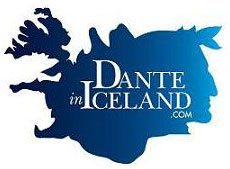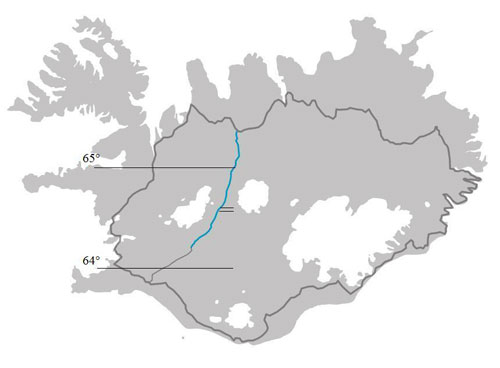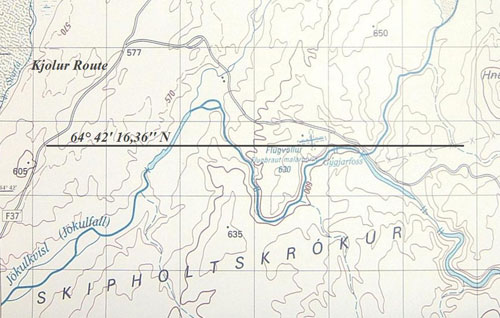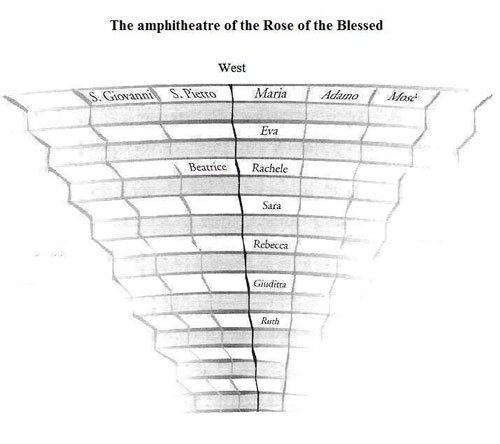Forsíða GÓP-frétta
*
Back to
Table of Contents
How
the Comedy
pinpoints the site in Iceland
Hvernig kvæðið vísar á Skipholtskrók
Table of
Ancient Units of Length
Tafla yfir
fornar lengdareiningar
Leiðin liggur til Íslands
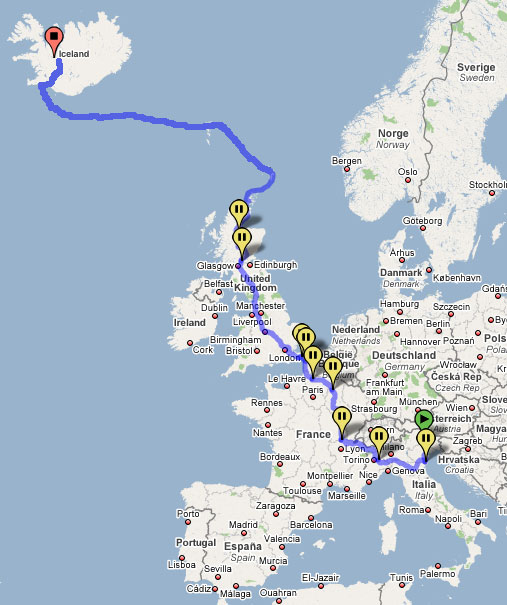
Dante´s trip to Iceland - Ferðaleið Dante til Íslands
in Purgatorio XXXIII
"Tibi serviat ultima Thyle" (Virgilio, Georgiche, libro I, 30).
With these words Virgilio wishes Ottaviano to reach with his empire the lands of the extreme north.
Until now nobody could say precisely where Tule was.
In the Comedy there is an important confirmation that Iceland is the ancient Tule.
The verse (Purgatory XXXIII, 55) where in the Comedy you can read the letters TU LE is near the verse (Purgatory XXXIII, 66) where Dante gives the geographic coordinates of the island near the Arctic Circle (66° 33' N, verse 66, XXXIII).
It can't be a casual thing!
In the comedy there are 14.233 verses!
"Tibi serviat ultima Thyle" (Virgilio, Georgiche, libro I, 30).
Með þessum orðum óskar Virgilio Ottaviano þess að
(Róma)veldi hans nái til þess lands sem er fjærst í norðri.
Fram til þessa hefur enginn getað sagt nákvæmlega hvar Tule var.
Í Gamanleiknum eru mikilvægar staðfestingar á því að Ísland sé hið forna Tule. Versið (Hreinsunareldurinn XXXIII, 55) þar sem lesa má stafina TU LE er nærri versinu (Hreinsunareldurinn XXXIII, 66) þar sem Dante gefur gráðu-hnit eyjunnar við heimskautsbauginn (66o 33' N, vers 66, XXXIII).
Hér getur ekki verið um tilviljun að ræða.
Í Gamanleiknum eru 14.233 ljóðlínur!


XXXIII,52: Tu nota; e sì come da me son porte,
XXXIII,53: così queste
parole segna a' vivi
XXXIII,54: del viver ch'è un correre
a la morte.
nota means note, observe but also mark : write the two letters TU
paro means in the same way
segna means teach but also mark : in the same way write the two letters LE.
English version:
Note thou (TU); and even as by me are uttered
These words, so teach them (LE) unto those who live
That life which is a running unto death;
mark, write the two letters TU
mark, write the two letters LE
XXXIII,52: Tu nota; e sì come da me son porte,
XXXIII,53: così queste
parole segna a' vivi
XXXIII,54: del viver ch'è un correre
a la morte.
nota merkir taktu eftir - en einnig merktu : skrifaðu stafina TU
paro merkir á sama hátt
segna merkir kenndu - en einnig merktu : á sama hátt skrifaðu LE
Enska þýðingin
Taktu eftir: og jafnvel eins og af mér tjáð
þessi orð, svo kenn þau þeim sem lifa
því lífi sem að rennur inn til dauðans.
Þýðingin hefur gulltryggt misskilninginn á vísunni.
Ljóst er að leggja verður ítalska frumtextann til grundvallar til að átta
sig á hinum leynda boðskap.
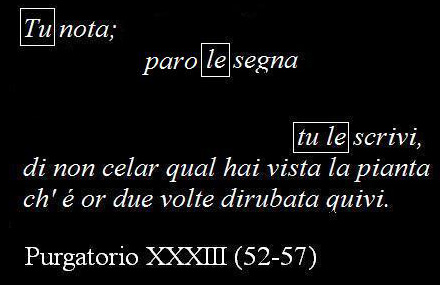
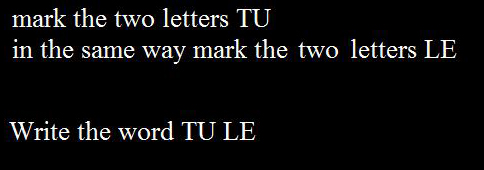

XXXIII,56: di non celar qual hai vista la pianta
XXXIII,57: ch'è or due volte dirubata quivi.
write TU LE
twice revealed in a hidden and difficult way here in these verses
English version:
And bear in mind, whene'er thou (TU) writest them (LE),
Not to conceal what thou hast seen the plant,
That twice already has been pillaged here.
write TU LE
twice revealed in a hidden and difficult way here in these verses
XXXIII,56: di non celar qual hai vista la pianta
XXXIII,57: ch'è or due volte dirubata quivi.
skrifaðu TU LE
tvisvar sýnt á hulinn og vandfundinn hátt hér í þessum versum
Enska þýðingin:
Og haf í hug hvenær sem ritar þau
eigi að dylja hvað þú hefur séða plöntuna,
sem þegar tvisvar hefur hér verið tjáð.
Hér er engin leið að skilja að skrifa skal TU LE og orðin um það sem tvisvar hefur verið skráð hljóta að vísa til einhvers yfirskilvitlegs.



XXXIII,65: per singular cagione essere eccelsa
XXXIII,66: lei tanto e sì travolta ne la cima.
Your mind is sleeping if you don't think of
a place (an island) at a very high latitude
and so cut in the north (66° 33' N, the Arctic Circle cuts the island in the north.)
English version:
Thy genius
slumbers, if it deem it not
For special reason so pre-eminent
In height, and so inverted in its summit.
so cut in the extreme north by the Arctic Circle at 66° 33' N
XXXIII,65: per singular cagione essere eccelsa
XXXIII,66: lei tanto e sì travolta ne la cima.
Hugur þinn dottar ef hann ekki er
við stað (eyju) á afar hárri breiddargráðu
og afskorin mót norðri. (Á 66° 33' N sker heimskautsbaugurinn eyjuna lengst í norðri.)
English version:
Hugur þinn
dottar ef hann ekki dæmir
af sérstökum sökum svo for-ágætur
í hæð, og svo viðsnúinn í toppinn.
(GÓP: Þarflaust er að taka það fram að þessar íslensku þýðingar úr enskunni eru auðvitað langt frá því sem Dante hefur hugsað sér í sínum ítalska texta. Það á sennilega einnig við um ensku þýðingarnar.)



TULE is at the verse 55, and 55° west from Jerusalem there is ICELAND.
- if we consider TULE, 55° from Jerusalem (35° 15'' East) we obtain 19° 45' W in the middle of Iceland near the site in Kjolur, a general indication for Iceland.
- If we consider TU at the beginning of the verse 52, we obtain 16° 45' W the place in the north-east where Iceland reaches the latitude of the Arctic Circle at 66° 33' N.
- if we consider HERE (twice hidden here) at the end of verse 57, and so 58° from Jerusalem, we obtain 22° 45' W the other place in the north-west near the Arctic Circle.
Now the general meaning of these verses of Purgatory XXXIII is clear.
In the verses from 64 to 66 Dante gives the latitude of the island where Arctic Circle "cuts" Iceland. The words so pre-eminent in height suggest that in this point Dante is talking about the extreme latitude north. In the verses from 52 to 58 Dante gives the positions in longitude of the two points in the north where Iceland "is cut" by Arctic Circle. The verse that life which is a running unto death suggests the dawn and the sunset, from east where sun rises to west where sun dies, here Dante is talking about longitudal distances towards west from Jerusalem.
TULE er nefnt í versi 55. Ísland er 55 gráðum vestan við Jerúsalem.
- Ef við færum færum staðsetningu TULE (55 gráðum vestan við Jerúsalem) inn í þá staðsetningu sem nú er notuð og miðast við Greenwich, þar sem Jerúsalem er á 35° 15'' Austur, þá fæst staðsetningin 19° 45' sem er inni í miðju Íslands nærri þar sem nefnist Kjölur. Þetta mundi vera almennt góð bending á Ísland.
- Ef við lítum sérstaklega á stafina TU í upphafi 52. vers fáum við staðsetninguna 16° 45' W sem er á norðaustur Íslandi þar sem landið er skorið af heimskautsbaugnum 66° 33' N.
- ef við skoðum sérstaklega orðið quivi (HERE) (tvisvar hulin hér) í lok 57. vers og erum þar með 58 gráðum vestan við Jerúsalem fáum við staðsetninguna 22° 45' W sem er annar staður á norð-vestur Íslandi nærri heimskautsbaugnum.
Þar með er ljós boðskapur þessara versa í Hreinsunareldinum XXXIII.
Í versunum frá 64 til 66 gefur Dante breiddarstöðu eyjarinnar þar sem heimskautsbaugurinn "sker" Ísland. Orðin so pre-eminent in height vísa til þess að Dante er að segja frá afar hárri, norðlægri, breiddargráðu. Í versunum 52 til 58 gefir hann lengdargráður þeirra tveggja punkta í norðri þar sem Ísland er "skorið" af heimskautsbaugnum. Orðin that life which is a running unto death vísa til þess að hann horfir með sólinni frá uppkomu hennar í austri til sólseturs í vestri sem merkir að hann er vestan við Jerúsalem.
in Iceland
and the right latitude along the Kjolur Route
are indicated in the Comedy
Hvernig vísar kvæðið á fjallveginn Kjöl
og á þær breiddargráður
sem um er að ræða
When I had journeyed half of our life's way,
I found myself within a shadowed forest,
for I had lost the path that does not stray. 3
Where is the right path
that goes straight to the right place?
Purg XXVII
v. 64 The path we took climbed straight within the rock,
or more faitfull to italian verse
v. 64 dritta salia la via per entro'l sasso
v. 64 the path goes straight within the rock
v. 64 Kjolur route goes straight within the island
v. 64 Kjolur route goes straight within ICELAND
Where inside ICELAND along the Kjolur Route?
Between 64° - 65° N
64° N dritta salia la via per entro'l sasso
65° N
64° N Kjolur route goes straight within ICELAND 65° N
Er ég hafði farið hálfa lífs vors braut
fann ég mig í skuggsælum skógi,
því ég hafði týnt slóðinni sem hvergi hvikar.
Hver er slóðin
sem liggur beint á réttan stað?
Purg XXVII
v. 64 Slóðin sem við fórum lyftist beint innan klettsins,
eða - eins og segir í ítalska textanum:
v. 64 dritta salia la via per entro'l sasso
v. 64 slóðin fer beint innan klettsins
v. 64 Kjölur liggur beint innan/gegnum eyjuna
v. 64 Kjölur liggur beint í gegnum Ísland
Hvar í Íslandi þegar farinn er Kjalvegur?
Milli 64° og 65° N
64° N dritta salia la via per entro'l sasso
65° N
64° N Kjolur route goes straight within ICELAND 65° N
In the original italian version in the verse before this
(Purg XXVII, 63) there is the repetition of a sound.
The sound of the letter N. Alliteration of letter N.
Thus here the key word is ENTRO and the precise position is given by the letter N:
64° N dritta salia la via per entro'l sasso
65° N
64° N drit-ta-sa-lia-la-via-per-en-tro'l-sas-so 65° N
The number of the verse (64) gives the degree, the posistion of the letter N gives the minutes and seconds,
The letter N is between 7,5 and 8 syllables out of
11
The middle of letter N
is 7,75 syllables out of 11
64° + (7,75/11 * 60)' N = 64°+42,27' N =
= 64° + 42' + (0,27*60)'' N
= 64° 42' 16,36'' N
>> The latitude of our RIVER
Í frumtextanum í næstu línu á undan
(Purg XXVII, 63) er hljóðrím, stuðlun.
Stuðullinn er bókstafurinn N.
Lykilorðið er ENTRO og nákvæm staðsetning er gefin með bókstafnum N:
64° N
dritta salia la via per entro'l sasso 65° N
64° N drit-ta-sa-lia-la-via-per-en-tro'l-sas-so 65° N
Númer línunnar í kvæðiskaflanum (64) segir til um heilu gráðuna. Staðsetning bókstafsins N segir til um mínútur og sekúndur.
Bókstafurinn N er milli atkvæðis nr. 7,5 og atkvæðis
nr. 8 af alls
11
Miðja bókstafsins N
er í stöðu atkvæðis nr. 7,75 af alls 11
64° + (7,75/11 * 60)' = 64° 42' 16,36'' N
>> sem er breiddarbaugur árinnar
The River
The right latitude along the Kjolur route is indicated in
Purgatory XXVII.
From the next song, Purgatory XXVIII, Dante begins to describe the river in
a way we can recognize it.
Rétta breiddargráðan er gefin í Purgatory XXVII.
Í næsta kafla, Purgatory XXVIII, er ánni lýst þannig að þekkja má að um er
að ræða þessa á - þ.e. Jökulfallið á þessu svæði.
Then he chooses "the little step of Matelda", the second of longitude in
that point (every little step of Matelda = 13,25 m).
At the meeting point with Matelda the water of the river flows towards North
and the water is never reached by the rays of the sun.
In fact there are high rock-walls at East, at West and at South.
Þá velur hann - litla skrefið hennar - sem er sekúnda lengdargráðunnar á þessum stað - þ.e.: 13,25 m.
Frá fundarstað þeirra Matildu rennur áin til norðurs þannig að geislar sólarinnar ná hvergi til hennar. Þar rennur Jökulfallið í djúpu gljúfri með veggjum austan við, vestan og sunnan.
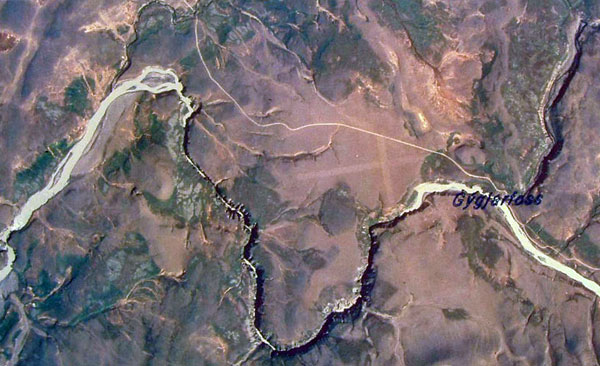
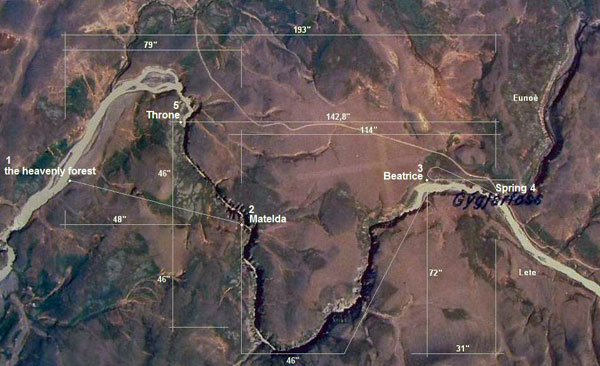
The throne of Beatrice is instead 46'' towards North from the meeting point
with Matelda (Pg XXIX, 8)
When Dante finally meets Beatrice, she tells him that he had to go in the
opposite direction to see her seated in her throne in the amphitheatre of
the White Rose of the Blessed (Pg XXXI, 47)
The stone that divides the two rivers at the waterfall is 114'' East from
the meeting point with Matelda (Pg XXXIII, 114)
The throne of Beatrice 142,81'' West from the stone at the waterfall (Pa XXXII, 142).
Hins vegar er hásæti Beatrísu 46'' í norður frá fundarstað þeirra Mateldu (Pg XXIX, 8)
Þegar Dante loks hittir Beatrísu segir hún honum að hann yrði að fara í hina áttina til að sjá hana í hásæti sínu yfir (vatns)leikjasviði Hvítu rósar hinna Blessuðu (Pg XXXI, 47)
Steinninn á ármótunum við Gýgjarfoss er 114'' austan við fundarstað Dante og Mateldar (Pg XXXIII, 114)
Hásæti Beatrísu er 142,81'' vestan við steininn á ármótunum (Pa XXXII, 142).
The stone between the two rivers:
Jökulfall (in the Comedy: Lete) the
great glacical river
and
Blákvísl (in the Comdy: Eunoè) the clearwater stream from left,
at the Gýgjarfoss waterfall.
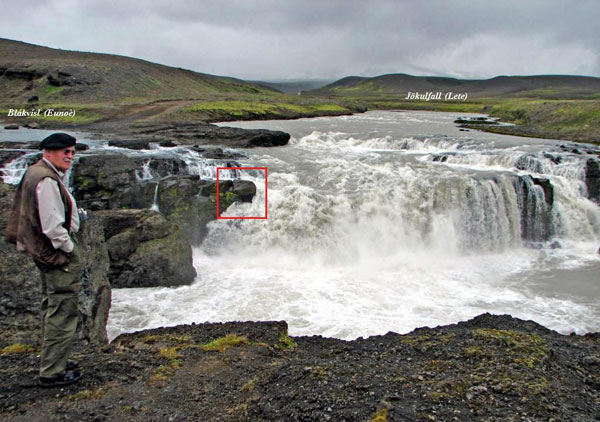
Mouse here for greater pictures
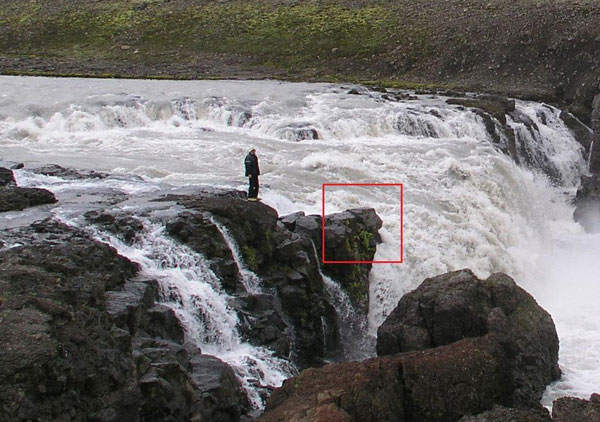
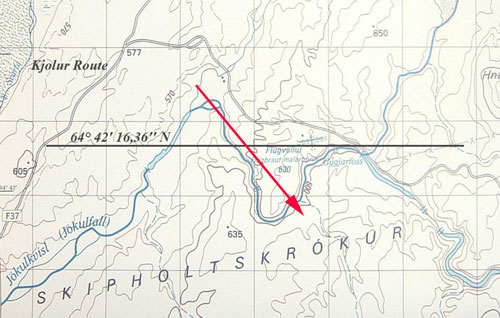
The red arrow shows the shooting-direction of the next photo.
Rauða örin sýnir tökustefnu næstu myndar.
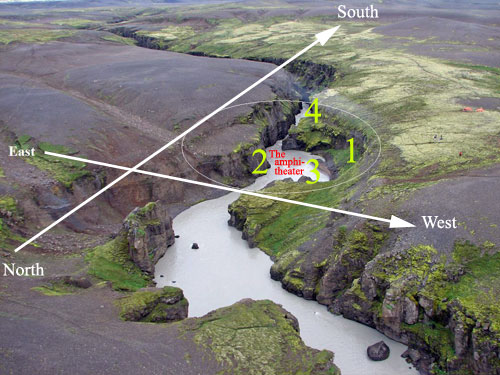
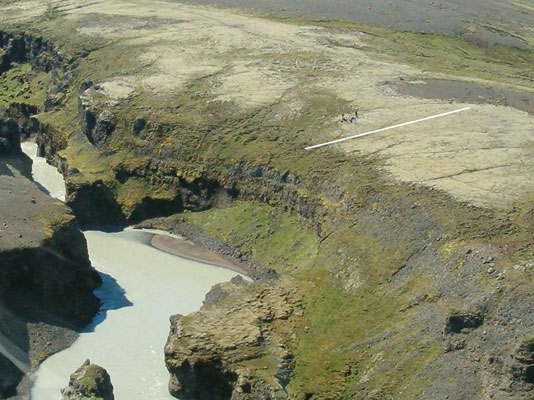
Down from the end of the white line in the middle of the
picture
is the green slope from under the rocks down to the river.
This is the western side of the amphitheater.
Upp frá ánni er gróðrivaxin brekka upp að klettabeltinu
undir enda hvítu línunnar á miðri myndinni.
Þetta er vesturhlið vatnsvangsins.
At the West Side
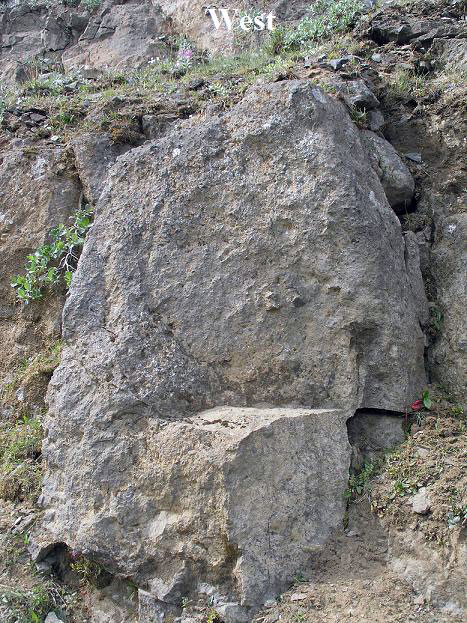
The Throne - Mouse here for a better overview.
1West - fyrir miðju til vesturs
The Throne of Beatrice (Pa XXXI)
Hásæti Beatrísu
At the East Side
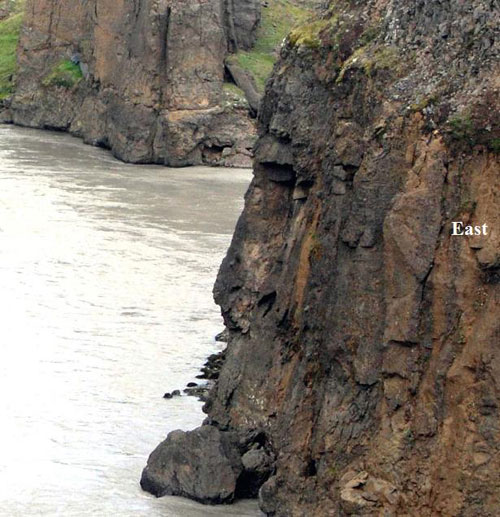
2 - East - gegnt sæti Beatrísu
The face of the Holy Shroud (see the end of Vita Nova)
Andlitsfall Krists í kletti í austurvegg gilsins.
At the North Side
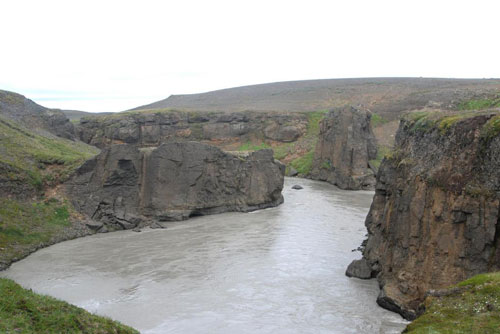
View to the North Side - Mouse here for larger photos
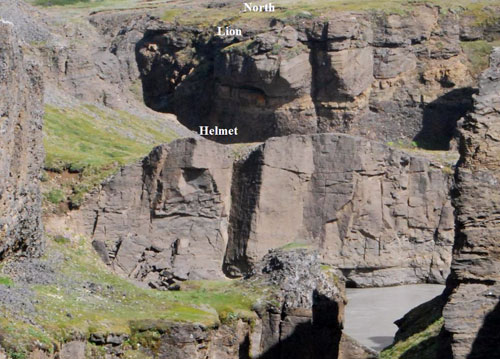
Helmet = The Warrior = Mars
Lion

Helmet = The Warrior = Mars
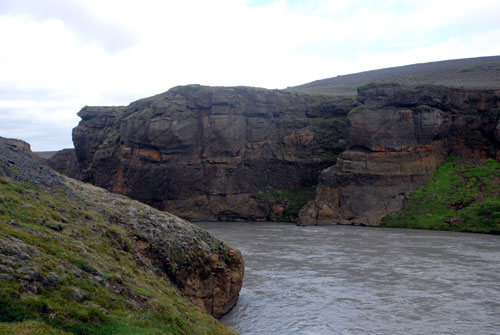
The Lion-Rock at the river
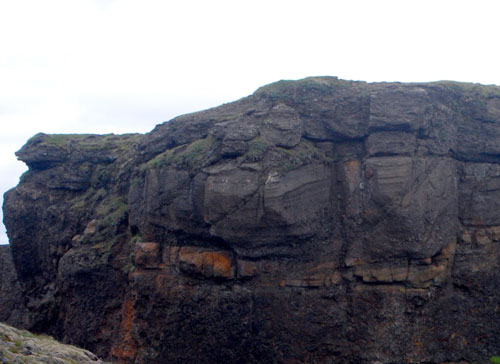
The head of the lion is seen in the nearest rock. Do you make it out?
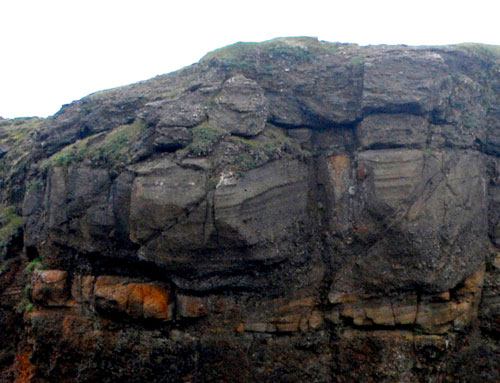
This is the head of the lion.

Mouse here for larger photos
3 - North - til norðurs
The helmet (the warrior) and the Lion (Pa XV, Pa XVI)
Hjálmurinn og ljónið.
At the South Side
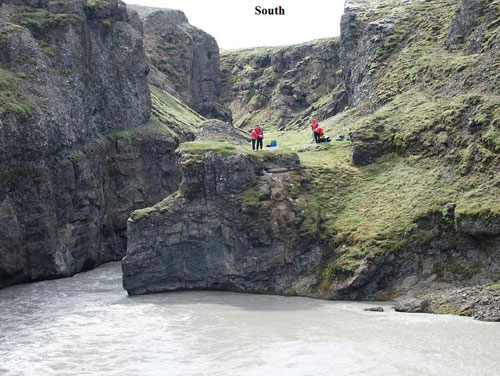
4 - South - til suðurs
The Eagle (the swooping down Eagle) (Pg IX, Pa VI, Pa XX)
Örninn í niðursteypingu.
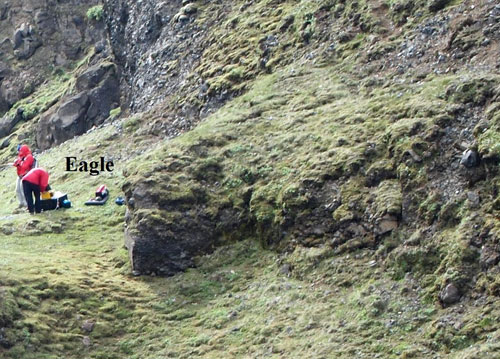
The eagle - Örninn
44,46 m = 100 roman cubits (Pa XX, 100).
So the Throne of Beatrice is
>> 46'' N from Matelda,
>> 142,81'' W from the waterfall,
>> 100 roman cubits from the Eagle's Eye,
>> 3" N from the tail of the fish.
These 4 measures match perfectly with the Comedy.
44,46 m = 100 roman cubits (Pa XX, 100).
Hásæti Beatrísu reynist vera
>> 46'' N frá fundarstaðnum við Mateldu,
>> 142,81'' W frá Gýgjarfossi,
>> 100 roman cubit frá auga arnarins.
Þessar þrjár mældu fjarlægðir eru eins og kvæðið segir.
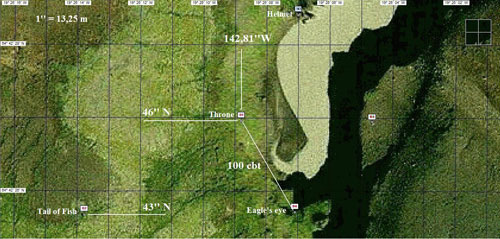

Same photo - a bit smaller and enlarged.
Sama mynd - ögn mjórri og stækkuð.
Validation
of the
Throne of Beatrice
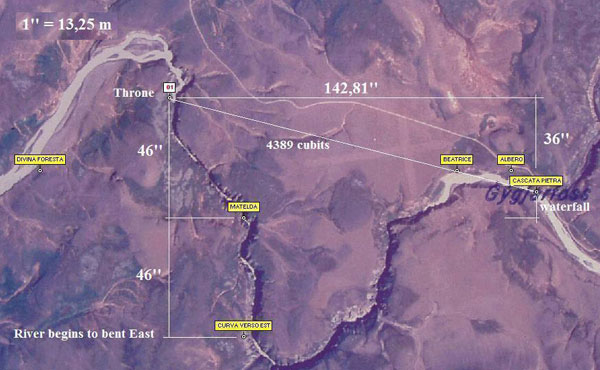
>> 46'' N from Matelda
>> 142,81'' E from the stone at the waterfall
The waterfall is:
>> 10'' N from Matelda
>> 114,00'' E from Matelda
So the Throne of Beatrice is:
>> 36'' N from the stone at the waterfall
>> 142,81'' W from the stone at the waterfall
Pitagora permits to obtain the distance of the Throne from the stone at the waterfall = 147,2776''
Every 1'' = 13,25 m so the distance is 1951,4284 m
Every roman cubit is 44,46 cm so the distance is 4389,18 roman cubits
The verse number 4389 of Paradise is the only one in the Comedy where Beatrice is seated on her Throne.
Paradise XXXI
v. 58 Where I expected her, another answered:
v. 59 I thought I should see Beatrice, and saw
v. 60 an elder dressed like those who are in glory.
v. 61 His gracious gladness filled his eyes, suffused
v. 62 his cheeks; his manner had that kindliness
v. 63 which suits a tender father. "Where is she?"
v. 64 I asked him instantly. And he replied:
v. 65 "That all your longings may be satisfied,
v. 66 Beatrice urged me from my place. If you
v. 67 look up and to the circle that is third
v. 68 from that rank which is highest, you will see
v. 69 her on the throne her merits have assigned her."
>> v. 69 is verse no. 4389 of Paradise. <<
Mældar fjarlægðir
á svæðinu sjálfu
reynast hinar sömu
og
reikna má út frá kvæðinu
á þann hátt
sem
Giancarlo Gianazza
hefur rökstutt.
Þess ber að geta að
fyrst
reiknaði hann
fjarlægðirnar
við lestur
kvæðisins,
á svæðinu
kom síðan í ljós
að
fjarlægðirnar
mældust
þær sömu.
In the west side of the amphitheatre,
46'' N from the meeting point with Matelda,
142,81'' W from the stone at the waterfall,
4389 roman cubits from the stone at the waterfall,
100 roman cubits from the Eagle's Eye
3" N from the tail of the fish.
All these measures match with the Comedy
fjarlægðirnar
reynast jafnar
því sem mælist
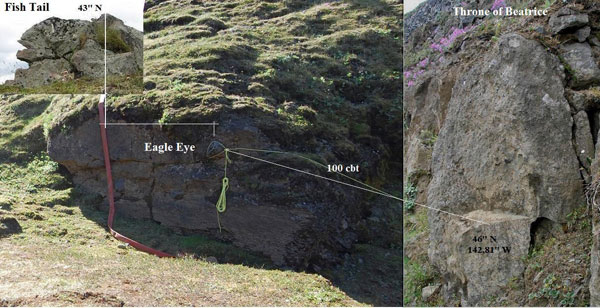
[Paradise 02.129
(Mandelbaum
Tr. and Longfellow Tr.)
The force and motion of the holy spheres
must be inspired by the blessed movers,
just as the smith imparts the hammer's art;
The power and motion of the holy spheres,
As from the artisan the hammer's craft,
Forth from the blessed motors must proceed.]
Paradise XXIV
v. 100 E io: "La prova che 'l ver mi dischiude,
v. 101 son l'opere seguite, a che natura
v. 102 non scalda ferro mai né batte incude".
In these verses there is a double meaning.
Dante is talking about miracles performed by Christ and faith. This the
plain reading:
v. 100 "The proof revealing truth to me relies
v. 101 on acts that happened; for such things,
v. 102 nature can heat no iron, beat no anvil."
The italian words "opere eseguite" can also mean manmade things, manmade objects, or, in our case, manmade sculptures:
v. 100 "The proof revealing truth to me relies
v. 101 on manmade sculptures; for such things,
v. 102 nature can heat no iron, beat no anvil."
The italian espression "heat the iron and beat the anvil" refers to the work of the smith, the hammer's art. This, he says, is impossibile for nature.
When he says that nature has not the proper instrument to perfome such miracles, he is also telling us that so many stones so properly shaped in the natural amphitheater can't be totally NATURAL. They must stem from a God's miracle or be at least partially man-made.
Dante is talking about our stones at the site:
the Throne of Beatrice, the Fish Stone, the Eagle's Eye, the Helmet (Warrior
or Mars), the Lion, the Face.
Some touch of hammer, some hammer's art was necessary. Men shaped these stones and measured their position.
Paradís XXIV
v. 100 E io: "La prova che 'l ver mi dischiude,
v. 101 son l'opere seguite, a che natura
v. 102 non scalda ferro mai né batte incude".
Í þessum línum er tvöfaldur boðskapur.
Dante er að tala um trúarleg kraftaverk.
Samkvæmt orðanna hljóðan segir hér:
v. 100 "Sönnunina sé ég
v. 101 í atburðum sem hafa orðið; ei til slíks
v. 102 hitar náttúran járn og dengir á steðja.
Ítölsku orðin "opere eseguite" geta einnig vísað til manngerðra hluta, í þessu tilfelli: kletta og kynjamynda sem menn hafi mótað að einhverju leyti:
v. 100 "Sönnunina sé ég
v. 101 í mótuðum hlutum; ei til slíks
v. 102 hitar náttúran járn og dengir á steðja.
Ítalska orðtakið "heat the iron and beat the anvil" vísar til smiðsins og leikni hans með hamarinn, smiðshöggið. Dante segir að það ráði náttúran ekki við án mannlegrar aðstoðar.
Fullyrðing hans um að náttúran ráði ekki yfir þeim tækjum sem þarf til að móta sköpulag klettamyndananna segir lesandanum að menn hafi hér slegið nokkur smiðshögg.
Um er að ræða steina og klettamyndanir á svæðinu:
Sæti Beatrice, Stein-fiskinn, Arnaraugað, Hjálminn (stríðsmaður - eða Mars),
kletta-ljónið og Krists-andlitið.
Sem sagt:
Smiðshögga var þörf. Menn hafa stílfært þessar klettamyndanir og mælt fjarlægðir milli þeirra.
* * *
Frá Wikipedia: Length * Fornar lengdareiningar
Modern metrologist have found the Roman foot to be 16⁄28 of the Nippur cubit: 29,6352 cm.
|
Roman unit |
Latin name |
Feet |
Equivalence |
Icelandic name |
|
one digit |
digitus |
1⁄16 |
18.5 mm |
stafur = fingur |
|
one inch |
1⁄12 |
24.6 mm |
tomma | |
|
one palm |
palmus |
1⁄4 |
74 mm |
lófi = þverhönd |
|
one foot |
pes |
1 |
29.6 cm[1] |
fet |
|
one cubit |
cubitus |
1 1⁄2 |
44.4 cm |
alin |
|
one step |
gradus |
2 1⁄2 |
0.74 m |
skref |
|
one pace |
5 |
1.48 m |
faðmur | |
|
one perch |
pertica |
10 |
2.96 m |
stöng |
|
one arpent |
actus |
120 |
35.5 m |
? |
|
one stadium |
stadium |
625 |
185 m |
? |
|
one mile |
mille passuum (milliarium) |
5000 |
1.48 km |
míla |
|
one league |
leuga |
7500 |
2.2225 km |
? |
Notes - Ath.:
- The value of the historical Roman foot scientifically obtained through modern statistical methods is 296.2 mm ± 0.5 mm, or about (296.2 ± 0.17%) mm (cf. Rottländer, Tübingen, Germany). The table above is based on this value, but rounded to the millimetre precision for the foot.
- Lengd hins fornrómanska fets hefur verið reiknað út með seinni tíma talnafræði og reynist vera 296.2 mm ± 0.5 mm eða um það bil (296.2 ± 0.17%) mm (cf. Rottländer, Tübingen, Germany). Þetta er útreikningsgrunnur töflunnar.
